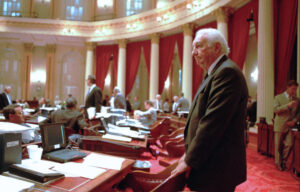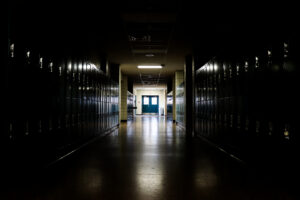As California Cities Enforce Housing Ban, Where Will the Unhoused Go?
There aren't nearly enough shelter beds available, but that isn't stopping localities from enforcing the ban following a recent Supreme Court decision. A tarp covers a portion of a homeless person's tent on a bridge overlooking the 101 Freeway in Los Angeles on Feb. 2, 2023. (AP Photo/Jae C. Hong)
A tarp covers a portion of a homeless person's tent on a bridge overlooking the 101 Freeway in Los Angeles on Feb. 2, 2023. (AP Photo/Jae C. Hong)
On a blistering 117-degree Friday in late July, Kenyan McCarthy, 53, and Kellie, 66, sat in a park in Palm Springs, California, and discussed the city’s new ban on camping and sleeping on public property.
Kellie, who asked that her last name not be used, suggested responding by moving whenever the police appeared.
“But at some point, you have to sleep,” McCarthy reminded her.
A few days earlier, Gov. Gavin Newsom (D) had issued an executive order directing state officials to clear encampments on state property. Local governments aren’t bound by it, just “encouraged” to adopt similar policies — although Newsom previously withheld homelessness funding from localities whose plans for handling the issue he deemed unacceptable. Los Angeles Mayor Karen Bass has notably pushed back against Newsom’s order.
Newsom’s order was bolstered by a recent Supreme Court decision, which ruled that localities can criminalize sleeping and camping outdoors, even when no shelter is available, reversing a 9th Circuit Court decision that provided some protection to people sleeping outdoors.
A few days earlier, Gov. Gavin Newsom had issued an executive order directing state officials to clear encampments on state property.
“It’s not a solution. It’s like, ‘Let’s look like we’re doing something, it’s a voting year,’” said Sean Ligman, who has stayed in various encampments in Palm Springs for the past year and a half. “It’s a way to deal with, in my opinion, the public feelings about it.”
Earlier in July, the Palm Springs City Council approved a ban on camping and sleeping on public property. The ban, which goes into effect this fall after new transitional housing units become available, applies to people sleeping in places like sidewalks, medians and parks when shelter space is available. Camping in riverbeds, flood-control channels and bus shelters is punishable even when there are no shelter beds.
During the six years before the Supreme Court reversed the 9th Circuit Court’s decision, encampment sweeps still occured. When shelter was unavailable, however, cities could not ticket or arrest people merely for sleeping outdoors, although they could make arrests for other reasons. In Palm Springs, for example, the police department made over 700 arrests among the city’s unhoused population from February 2023 to March 2024.
Now, Palm Springs is one of several California cities, including Fresno and San Francisco, that have begun implementing and enforcing camping bans. Other Western cities, including Missoula, Montana, and Portland, Oregon, have begun enforcing their own versions of such bans.
California has the largest number of unhoused people in the nation. But given that the need for beds far exceeds current shelter capacity, it’s an open question as to where those people are supposed to go.
Ligman says the Palm Springs police provide notice before a sweep, so he simply leaves before they return. But he describes a frequent rotation of people moving from place to place following sweeps.
“[Moving around] is just going to be another thing to add to our daily things that we have to factor into our lives,” said Ligman.
In some cases, encampment sweeps only temporarily clear an area, with people often returning within a few months. In the meantime, however, the sweeps cause cascading impacts: People lose important documents and belongings and sever connections with local service providers. Criminalizing homelessness through arrests and fines can also make it even harder to exit homelessness; people with criminal records have a tough time securing jobs and housing.
Given that the need for beds far exceeds current shelter capacity, it’s an open question as to where those people are supposed to go.
“You create a family” when you become part of an encampment, said Emma Rivera, who joined one when she ended up unhoused this year after a car accident. “And when those encampments get torn down, I mean, it’s devastating. What else are we supposed to do?”
Rivera left the last encampment in June after law enforcement cleared it. Since then, Rivera has stayed in the city’s new Navigation Center, which opened in March and currently offers 50 overnight beds. In order to secure a bed, however, individuals must check in at a separate facility at 8 a.m. each day, then return again around 3 p.m. to board a bus to the shelter.
“You get your bed, and then try to work the process of finding a place or starting a Section 8 application or looking for a job with that little bit of time that you have [in between],” Rivera said.
Ligman and McCarthy cited this schedule as an obstacle to using the shelter: It takes up most of their day, and they can’t arrive on their own. Others, like Charlie Cash, who works at a KFC, miss the check-in due to their work hours.
While Palm Springs now has a shelter, many other suburbs and smaller cities in California do not, even though these areas have seen some of the state’s largest increases in homelessness in recent years. Chris Herring, a homelessness expert and a sociology professor at the University of California Los Angeles, foresees a possible “race to the bottom” as cities pass more and more aggressive anti-camping ordinances.
“It will be interesting to see if unhoused folks actually migrate to the other side of a border of a given locality, and if that happens, of course you’ll have political uproar in that area and political pressure to do the same in that area, and to push it even more extreme,” Herring said.
Back at the Palm Springs park, McCarthy said the new ordinance will simply push him out of public view, since he thinks enforcement will occur “when someone sees you, and you become unsightly.”
“Their goal is they want to harass you enough until you leave,” McCarthy said. “Now, you can leave by choice or by circumstance — that means you got locked up. And if that doesn’t happen, they want you to disappear.”
Your support matters…Independent journalism is under threat and overshadowed by heavily funded mainstream media.
You can help level the playing field. Become a member.
Your tax-deductible contribution keeps us digging beneath the headlines to give you thought-provoking, investigative reporting and analysis that unearths what's really happening- without compromise.
Give today to support our courageous, independent journalists.






You need to be a supporter to comment.
There are currently no responses to this article.
Be the first to respond.